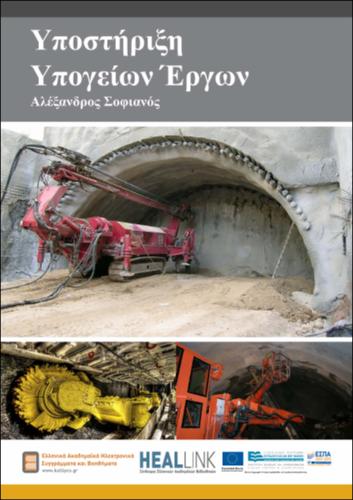| Title Details: | |
|
Support for Underground Works |
|
| Authors: |
Sofianos, Alexandros |
| Reviewer: |
Nomikos, Pavlos |
| Subject: | ENGINEERING AND TECHNOLOGY > TECHNOLOGICAL SCIENCES AND ENGINEERING > MINING AND METALLURGICAL TECHNOLOGY AND ENGINEERING ENGINEERING AND TECHNOLOGY > TECHNOLOGICAL SCIENCES AND ENGINEERING > CONSTRUCTION TECHNOLOGY AND ENGINEERING > TUNNELS ENGINEERING AND TECHNOLOGY > TECHNOLOGICAL SCIENCES AND ENGINEERING > MINING AND METALLURGICAL TECHNOLOGY AND ENGINEERING > ROCK MECHANICS |
| Keywords: |
Rockbolts
Steel ribs Shotcrete Wedges Stratified roofs Rock pillars Cut and Fill Hydraulic props |
| Description: | |
| Abstract: |
The stability control of underground openings requires knowledge of the natural and induced stress field, the mechanical behavior of the surrounding rock, and the response of the measures taken to support them. Support measures widely used in conventional construction of both longitudinal and spatial underground openings are grouting, steel frames, concrete lining, and advance elements. These interact with the surrounding rock after installation. Since hard, soft, or crushing soil around underground longitudinal openings behaves macroscopically as a continuous medium, the assessment of the stress state is achieved by considering its interaction with the support. The behavior is assessed and, based on this, the support measures are selected and, where appropriate, displacements, overload or relaxation zones, the suitability of the cross-section shape, and the required and available support force with the stages of its application are calculated. If the rock behaves as a discontinuous medium, failure mechanisms are assessed. The following possibilities are identified: fall-sliding of individual blocks formed by combined joint systems in fragmented rocks, sliding-separation between layers formed by the distinct parallel layers commonly found in sedimentary rocks, or rock sliding-ejection in the particularly sensitive area of the tunnel face, due to discontinuous structures or overloading. Calculation methods and diagrams for estimating the required support are provided. Finally, specific stabilization measures applied in conventional underground mining are presented, such as natural rock support for mining with chambers and pillars, artificial support by filling empty faces for exploitation with alternating cuts and fillings, and hydraulic support for exploitation with long faces. Consolidation is achieved by selecting appropriate measures.
|
| Linguistic Editors: |
Pappas, Vasileios |
| Technical Editors: |
Bozionelos, Gavriil |
| Type: |
Undergraduate textbook |
| Creation Date: | 2015 |
| Item Details: | |
| ISBN |
978-960-603-459-6 |
| License: |
http://creativecommons.org/licenses/by-nc-nd/3.0/gr |
| DOI | http://dx.doi.org/10.57713/kallipos-660 |
| Handle | http://hdl.handle.net/11419/3457 |
| Bibliographic Reference: | Sofianos, A. (2015). Support for Underground Works [Undergraduate textbook]. Kallipos, Open Academic Editions. https://dx.doi.org/10.57713/kallipos-660 |
| Language: |
Greek |
| Consists of: |
1. Internal reinforcement – Rock bolts 2. Internal pre-reinforcement with long-length elements 3. Steel frames 4. Shotcrete lining 5. Support of rock blocks 6. Rockbolting flat stratified roofs 7. Intact strong rock surrounding an underground opening 8. Weak rock surrounding an underground opening 9. Response of support measures - The case of axisymmetric layout 10. Rock-support interaction 11. Rooms and Pillars 12. Backfilling of void spaces in faces 13. Straight longitudinal faces |
| Number of pages |
396 |
| Publication Origin: |
Kallipos, Open Academic Editions |
| You can also view | |
| User comments | |
There are no published comments available! | |

